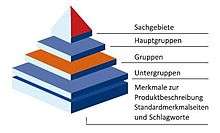ECl@ss
eCl@ss is a product classification for classification of products and services, which is maintained by the industry consortia eCl@ss e.V. association.
Use
eCl@ss supports the digital exchange of product descriptions and service descriptions, based on standardized data formats based on IEC 61360. It is used in engineering tools as base for transfer of planning data,[1] in ERP systems as base for product master data,[2] and as base for exchange of product data.[3][4]
Structure

The eCl@ss classification system is based on a hierarchical grouping of products and services. There are 4 levels of hierarchy:[5][6]
- Segments,
- Main group,
- Group,
- Sub-group or product class.
This classification provides a grouping from point of view of purchasing.[7]
A product class has a 1:1-relation to an application class. Application classes are described in further details with properties according IEC 61360.[5] This approach separates the definition of the classification hierarchy from the definition of the product descriptions.
Standards
The eCl@ss dictionary is based on international standards.
- The data model is defined according IEC 61360/ISO 13584-42.
- The identifiers of the classes and properties are based on ISO 29002-5.
- The release process follows ISO 22274.
Versioning
The eCl@ss e.V. association publishes regularly new versions of the eCl@ss dictionary. Different versions of the eCl@ss dictionary may differ in regard to defined classes and properties.[6]
In order to support the update of product data, which are based on eCl@ss, additional files are published for each version, that support automatized migration of product data.[2]
References
- "White paper AutomationML and eCl@ss integration" (PDF). Automation ML e.V. Retrieved September 25, 2018.
- Uiterwyk, Henning. "eCl@ss ADVANCED, Classification systems for engineering" (PDF). CADenas. Retrieved September 27, 2018.
- "eCl@ss wiki - Implementation Guide". eCl@ss e.V. Retrieved September 27, 2018.
- Yu, Yang; Hillman, Donald; Setio, Basuki; Heflin, Jeff. "A Case Study in Integrating Multiple E-commerce Standards via Semantic Web Technology" (PDF). ISWC 2009. Retrieved September 27, 2018.
- "eCl@ss wiki - Classification Class". eCl@ss e.V. Retrieved September 27, 2018.
- Wilkes, Wolfgang; Reusch, Peter J. A.; Garcia Moreno, Laura Esmeralda (2011). "Flexible classification standards for product data exchange". Semantic Scholar. Retrieved September 27, 2018.
- Hepp, Martin; Leukel, Joerg; Schmitz, Volker. "A Quantitative Analysis of eCl@ss, UNSPSC, eOTD, and RNTD: Content, Coverage, and Maintenance". ICEBE 2005. CiteSeerX 10.1.1.67.3622. Cite journal requires
|journal=(help)